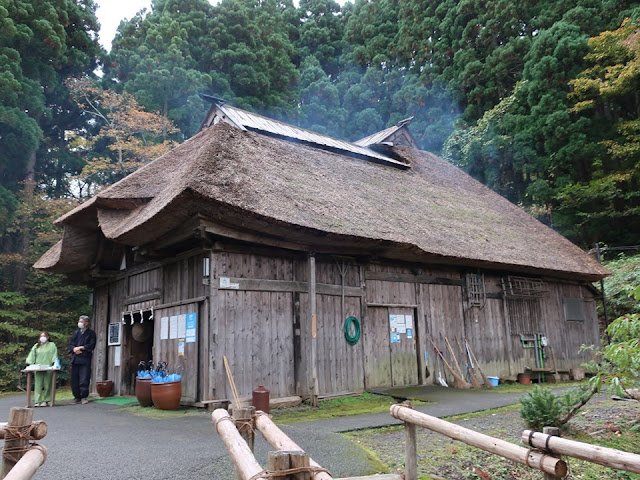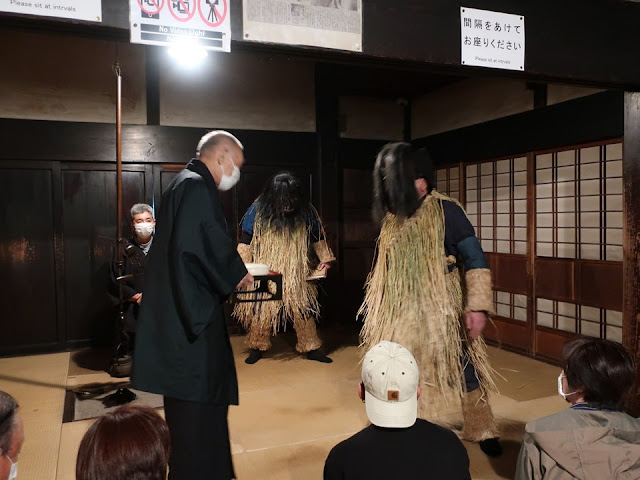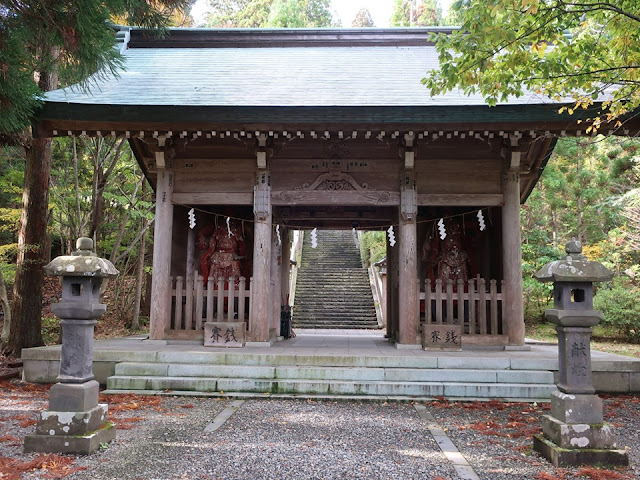Namahage, which is one of the most
famous rites, is performed in this museum. The proverb “Seeing
is believing” is true. It is an interesting rite.
秋田といえば“なまはげ”。伝承館では、その実演が行われています。これは「百聞は一見にしかず」です。楽しく、かつ、心温まる行事でした。
It is held on the New Year’s Eve when Shinzan village in Oga peninsula (Akita prefecture) is usually covered with snow. Three hundred of Namahage appear at the peninsula. They make a team which consists of two Namahage and one attendant, then they visit houses.
Namahage (photo above) seek for lazy people especially children and punish them. At the same time, they pray for the family’s happiness, a rich harvest and a good catch.
Btw, every Namahage team visits around ten families, which is the maximum number they can visit. Because, they are treated with sake (alcohol) in each house.
なまはげは、雪が積もっている大晦日の行事です。
男鹿には300匹のなまはげがいます。なまはげは、神なのですが、伝承館の方は“何匹と数える”といっていました。
伝承館がある真山(しんざん)は戸数60の村です。なまはげは三人一組で、一人は先導役です。真山神社に集合した後、一組が十戸ぐらいを廻ります。酒を飲むので、そのぐらいが限界だそうです。
真山のなまはげには角はなく、斧なども持ちません。家々を訪ねて、怠け者はいないかと、探し廻ります。
Namahage rite is performed in this old and local house.
男鹿の典型的な曲屋で実演されます。
An attendant, who is called “Sendachi”, visits the house at first, and asks the master whether Namahage could come in or not.
先立が、なまはげが入って良いですか、と尋ねます。主人は座敷でなまはげを迎えます。
Then Namahage come in, shout “Woo!” and stamp the floor loudly.
ウォーとなまはげ二匹が登場。四股をふみます。
Namahage start seeking for lazy people with shouting. Children have hidden already because of fear.
「怠け者はいねが」と探し回ります。
The master brings trays and ask them in warm local language, “Namahage-san, please sit down and drink a sake.”
主人が、膳を持って出てきて、「座って酒っけこ飲んでくなんし」と進めます。
When I visited, Namahage asked the harvest at first. The master answered, “Thanks to your prayer, it was a good harvest.”
Then, Namahage check their note on which the family members’ behaviors were written, and questioned him. Pls see the 30 second movie.
It is called “Namahage Qs and As”. Funny dialogue was performed in the museum.
ここからが「なまはげ問答」。私が見たときは、なまはげが、作物のでき、嫁や子供がまじめに過ごしているかを聞きました。主人は、「なまはげさんが拝んでくれたお陰で、上手くいっています」と返します。とても暖かい会話でした。
なまはげは、皆の様子が書かれた台帳(閻魔帳のようなものですね)を持って、怠けていないか、問いただします。続きは上の動画(30秒)でどうぞ。
Then, Namahage walk around the house again to find lazy children. The master brings mochi cakes and calms down Namahage. They talk to the master, “Hope everyone stays healthy, we will come again next year”, and go to the next house.
Namahage visit every house in order to pray the family’s happiness.
なまはげは、怠けている子はいないか、大きな足音を立てて家をもう一廻り。主人が餅を差し上げると、なまはげは、「皆まめ(健康)でれよ。来年まだくるがらな」と言って、次の家に行きます。
家に入る時7回、膳を前にして5回、問答をして立ち上がって3回、四股を踏むのが真山独自の慣わしだそうです。四股と言っても、相撲のように足を大きく上げるのではなく、ドンドンとステップを踏むという感じです。
なまはげは、家族の幸せを願って、山から下りてきて、家々を廻ってくれるのです。
There are New Year’s decorations in front of the Buddhist altar.
仏壇の前には、鏡餅。
【Word root of Namahage、なまはげの語源】
“Nama” is from “blotch” which appears on your skin if you stay at fire place for a long time. “Hage” means “peel”. If you are lazy and just stay by the fire place, blotch appears on your skin. Peeling off the blotch as punishment is the word root of “Namahage”.
炉端に居て何もしないと手足に火型ができます。秋田ではナモミといいますが、「ナモミを剥ぐ」という言葉がなまって、なまはげになったそうですよ。怠惰への戒めです。親に抱かれていた男の子は、ワーワー泣いていました。
As a lad, people perform Namahage,
and as a master, people treat Namahage.
What a wonderful folklore event this is!
成人したら、なまはげになって、家々を廻って酒を呑み、
主人になったら、なまはげを迎える。
こんないい行事はないですね。
The straw which fell from Namahage’s outfit are happy token, therefore, people keep them on the floor until the New Year’s Day.
Namahage rite is the last event in the year, and it is a doubtless fun time for people. By the way, Namahage behave roughly, so some families don’t accept their visit recently. I hope people continue it forever.
なまはげが落とした藁は幸せの記念品で、元旦まで残しておくそうです。
生活の彩りであり、雪が積もっている大晦日、1年のけじめであるとも思います。人の楽しみそのものです。最近では、なまはげは、家中で暴れ回るので、断っている家が増えているとの話もありますが、いつまでも続けて欲しい行事です。(かつては小正月の行事だったそうです)
Reference(参照):Museum all about Namahage in the same site、同じ敷地です Namahage Museum、なまはげ館
Shinzan Shrine、真山神社
This is the southern part of Oga peninsula from Mt. Kanpuzan. Three hundred of Namahage appear on the New Year’s Eve here.
寒風山から見た男鹿半島南側です。大晦日には300匹のなまはげが現れます。
Visited in October, 2020
Official website: https://namahage.co.jp/namahagekan/en/oga_shinzan_folklore_museum/
https://namahage.co.jp/namahagekan/oga_shinzan_folklore_museum/ (in Japanese), accessed in Jun, 2021
Previous post (Museum in the neighboring prefecture):
Fukaura history and folklore museum、深浦町歴史民俗資料館(青森県)
Next post (Museum
all about Namahage in the same site):












Comments
Post a Comment